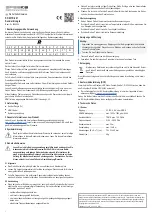
17
Ext Comm Cfg #5
∼∼∼∼
Ext Comm Cfg #8
: These four parameters designate
user-selectable drive parameter numbers for special processing. Their use is
different for each protocol, so refer to the protocol-specific sections of this
manual for further details.
7.2
Additional Parameter Settings
Although the drive parameters outlined in section 7.1 provide the majority of
the RS-485 network configuration, there are several other communication-
related parameters that must be set appropriately to ensure reliable
communication between the drive and the ASD-NANOCOM interface itself.
Verify that the following parameters in
Program…Comm Settings
are set as
indicated:
RS485 Baud Rate
......... Although any setting will work properly, it is
recommended to set this value to
38400
. This
setting will provide the maximum bandwidth
utilization between the drive and the ASD-
NANOCOM interface.
485 Timeout Time
....... Set to
0s
.
RS485 Res Time
............ Set to
0.00s
.
RS485 Master Out
....... Set to
Normal
.
7.3
Controlling the Drive from the Network
If drive control (frequency command input, RUN/STOP, etc.) is to be performed
via the RS-485 network, then the following ASD parameters in
Program…Utility Group
must also be set as shown:
Command Mode
................ set to ”
RS232/485
”
Frequency Mode
............ set to ”
Use RS232/485
”
As an alternative to setting the
Command
Mode
and
Frequency
Mode
selection parameters, the override (priority) bits may be activated in the RS-
485 command word (parameter FA04) instead. The specific method of
activating these bits depends on the protocol being used. For more
information on the proper use of the override bits, refer to the appropriate
Toshiba documentation regarding the drive’s command mode and frequency
mode control hierarchy.
Buy: www.ValinOnline.com | Phone 844-385-3099 | Email: [email protected]
















































